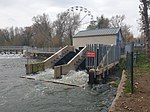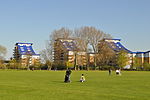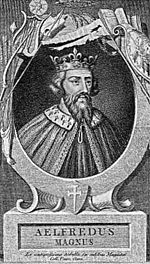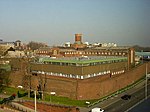Caversham Lock

Caversham Lock is a lock and main weir on the River Thames in England at Reading, Berkshire. Both the lock and main weir are connected to De Bohun Island (colloquially known as Lock Island). The Thames Navigation Commissioners built the original lock in 1778. Additional sluices north of View Island and Heron Island form the whole weir complex. A footbridge passes over all three islands to connect Lower Caversham to Reading via a route other than George Street and Reading Bridge. The weir is upstream of the lock and in the mid-channel. Kings Meadow, Reading, and buildings comprising homes and office blocks adjoin to the south of the lock itself. The island contains a typical lock-keeper's house, a crane depot, small boatyard, and large boathouse owned by the Environment Agency for occasional use by that authority and police in river patrol and maintenance of boats. The head of water provided by the weir is used by Reading Hydro to generate up to 46 kW of electricity.
Excerpt from the Wikipedia article Caversham Lock (License: CC BY-SA 3.0, Authors, Images).Caversham Lock
The Clappers, Reading Caversham
Geographical coordinates (GPS) Address Nearby Places Show on map
Geographical coordinates (GPS)
| Latitude | Longitude |
|---|---|
| N 51.4607 ° | E -0.9641 ° |
Address
Caversham Lock
The Clappers
RG1 8BP Reading, Caversham
England, United Kingdom
Open on Google Maps









